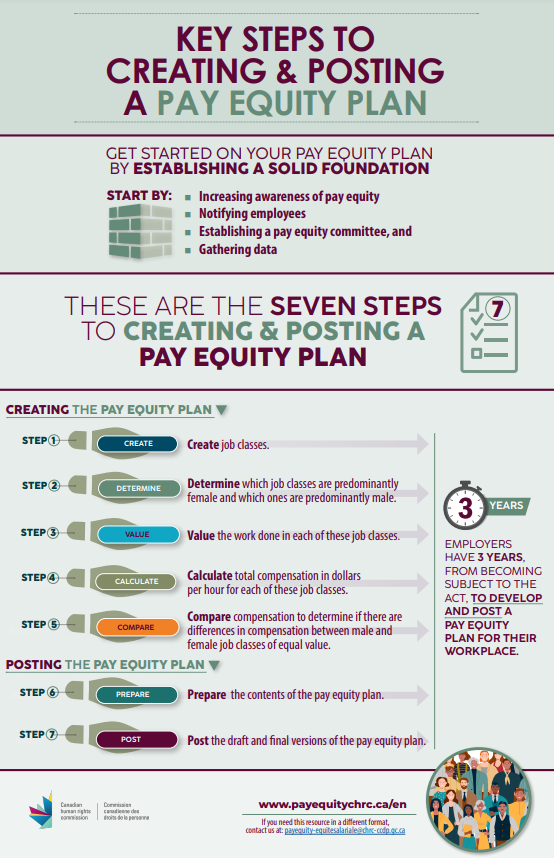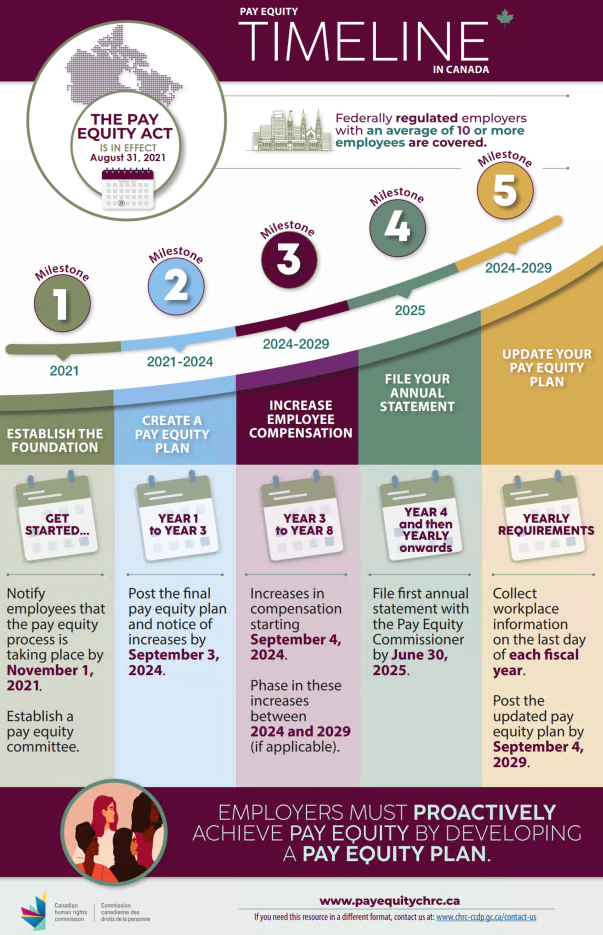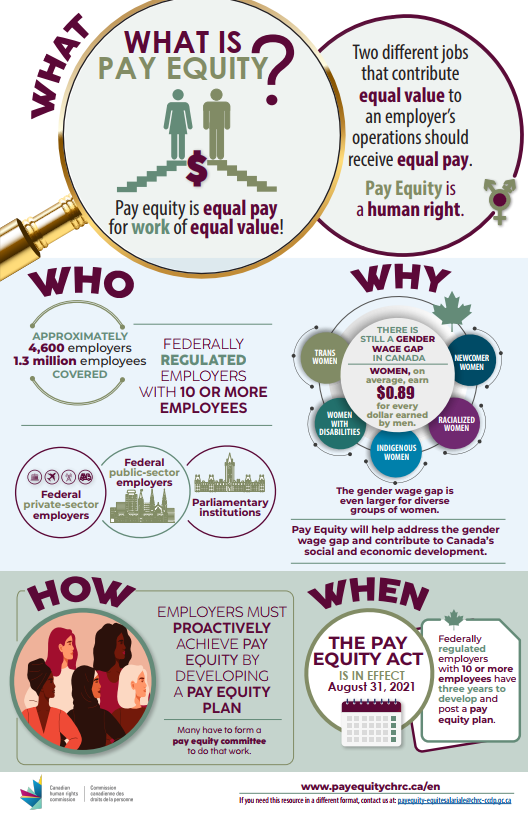Infographics
These infographics were developed by the Pay Equity Unit to promote the pay equity rights and obligations.
Key steps to creating and posting a pay equity plan
Here is what the infographic tells you:
Get started on your pay equity plan by establishing a solid foundation
It is important to support the development of your pay equity plan by establishing a solid foundation.
Start by:
- Increasing awareness of pay equity in your workplace;
- Notifying employees;
- Establishing a pay equity committee; and,
- Gathering all of the necessary data.
There are seven key steps to creating and posting a pay equity plan.
Once you have the foundation in place, create a pay equity plan by following these steps:
- Step 1 - Create: The first step is to create job classes.
- Step 2 - Determine: The second step is to determine which job classes are predominantly female and which ones are predominantly male.
- Step 3 - Value: The third step is to the value the work done in each of these job classes.
- Step 4 - Calculate: The fourth step is to calculate the total compensation in dollars per hour for each of these job classes.
- Step 5 - Compare: The fifth step is to compare compensation to determine if there are differences in compensation between male and female job classes of equal value.
Once the pay equity plan is complete, post it by following these final steps:
- Step 6 - Prepare: The sixth step is to prepare the contents of the pay equity plan.
- Step 7 - Post: The seventh step is to post the draft and final versions of the pay equity plan.
Employers have three years, from becoming subject to the Act, to develop and post a pay equity plan for their workplace.
You can visit the pay equity website for more tools and resources: www.payequitychrc.ca/en
If you need this information in another format, please contact us at payequity-equitesalariale@chrc-ccdp.gc.ca.
Pay Equity Timeline in Canada
Here is what the infographic tells you:
The Pay Equity Act came into effect on August 31, 2021.
Federally regulated employers with an average of 10 or more employees are covered and must meet various timelines.
Five major milestones sum up the process for achieving pay equity.
For each of these milestones, keep the following timelines in mind and mark these dates on your calendar:
- Get started...:
The first milestone is to establish a foundation for pay equity. Employers must get started by notifying employees that the pay equity process is underway by
November 1, 2021. They must also establish a pay equity committee if they are required, or choose to do so. - Year 1 to year 3:
The second milestone is to establish a pay equity plan. In years 1 through 3, workplaces must create a pay equity plan. Employers must post the final pay equity plan and notice of pay increases by September 3, 2024. - Year 3 to year 8:
The third milestone is to increase employee compensation. Increases in compensation must occur on
September 4, 2024. If applicable, employers may phase in these increases between 3 to 5 years or between
2024 and 2029. The length of the phase in period depends on the size of the employer. - Year 4 and then yearly onwards:
The fourth milestone is to file an annual statement to the Pay Equity Commissioner on year four after becoming subject to the Act and then yearly onwards. Employers are required to file their first annual statement by
June 30, 2025. - Yearly requirements:
The fifth milestone is to update the pay equity plan. In order to update a pay equity plan, employers must collect workplace information on the last day of each fiscal year. They are also required to post the updated pay equity plan by September 4, 2029.
You can visit the pay equity website for more tools and resources: www.payequitychrc.ca/en
If you need this information in another format, please contact us at payequity-equitesalariale@chrc-ccdp.gc.ca.
What is Pay Equity
Here is what the infographic tells you:
The Pay Equity Act ensures equal pay for work of equal value.
This means that two different jobs that contribute equal value to an employer’s operations, where one job is commonly held by women and the other is commonly held by men, should be paid equally.
Pay equity is not a privilege, it is a human right.
There is still a significant gender wage gap in Canada. Women earn on average $0.89 for every dollar earned by men.
For certain groups of women – such as trans women, women with disabilities, Indigenous women, racialized women and newcomer women – the gap is even greater.
The Pay Equity Act protects about 1.3 million employees working for about 4,600 federally regulated employers with an average of 10 employees or more. These employers range from the private sector (e.g. banking, communications and transportation sectors), to the public sector (e.g. federal public service) and Parliamentary institutions (e.g. House of Commons and Senate).
Achieving pay equity will help close the gender wage gap and contribute to Canada’s social and economic development.
To achieve pay equity, employers must work proactively to develop a pay equity plan within three years. The Act establishes a collaborative process whereby many employers will need to establish a pay equity committee to do the work.
The Pay Equity Act will come into force on August 31, 2021.
If you need this resource in a different format, contact us at: payequity-equitesalariale@chrc-ccdp.gc.ca.
- Date modified:


